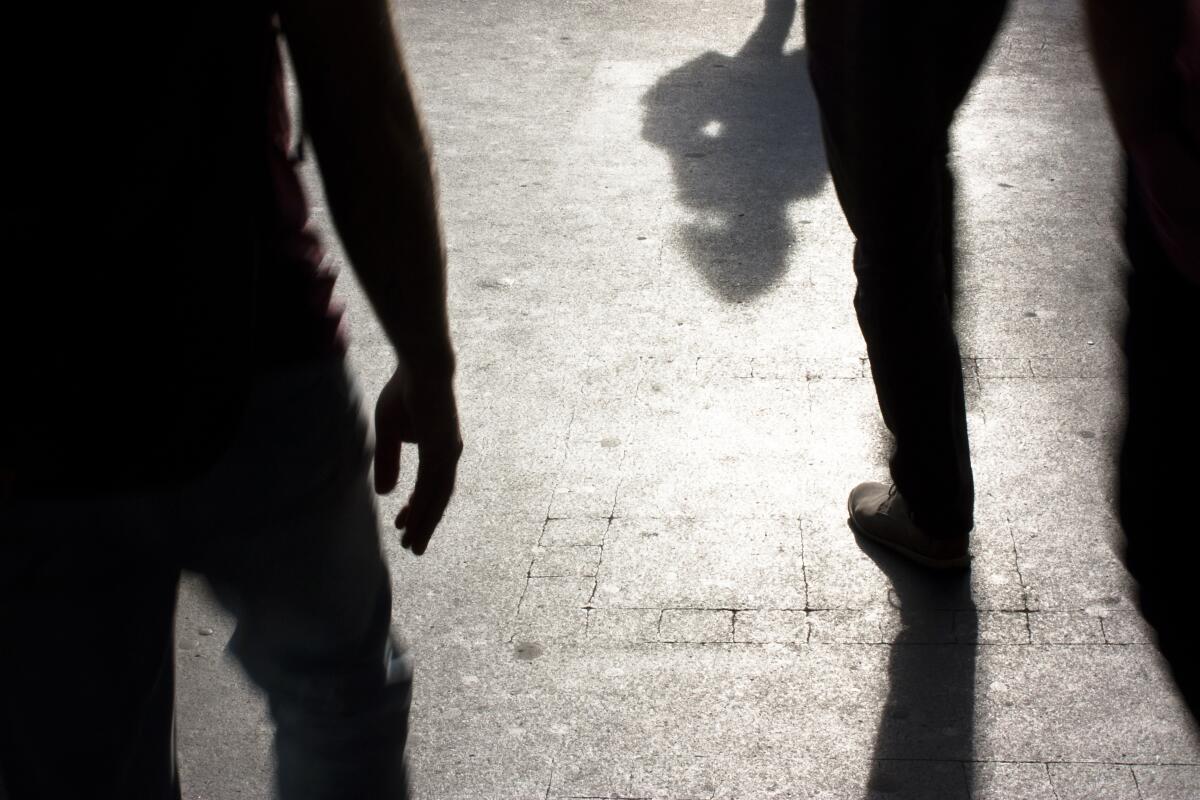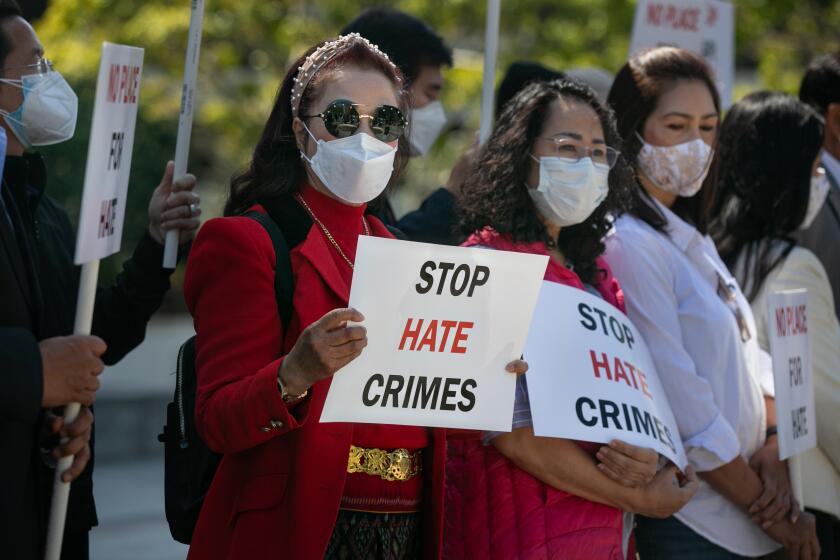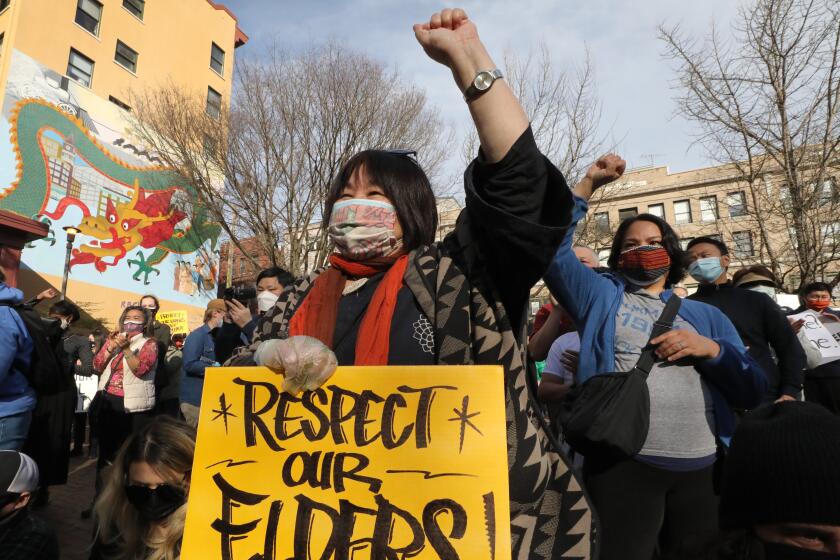Recent hate crimes are a wake-up call. What to do if you think you’re being followed

- Share via
The gruesome killing of Christina Yuna Lee in New York City this month rattled many women who could imagine themselves in the same situation. Lee was followed home after a night out with friends and stabbed to death in her Chinatown apartment. Asian American women have been on especially high alert with reports of anti-Asian harassment rising in the last two years.
“It was a wake-up call,” said Riffat Rahman, the program coordinator of the South Asian Network‘s gender-based violence prevention unit based in Artesia.
Rahman does safety planning with survivors of domestic violence and helps them come out of an unsafe environment. But in the last week, she found herself thinking about how she should advise her clients, family and friends to prepare for situations that are random and unexpected.
Those who work with sexual assault and domestics violence survivors — like Rahman and Jong-Ling Wu, the community services program manager for the Los Angeles-based Center for the Pacific Asian Family — are quick to remind people that the majority of these violent incidents come from someone you know. In most cases, the attacker is not a stranger jumping out of the bushes.
But some of the conversations around “stranger danger” that took hold in the ‘80s and ‘90s are coming back, Wu said, with the rise of hate incidents across the nation. A recent study from the Center for Hate and Extremism at Cal State San Bernardino reported that Los Angeles recorded the most hate crimes among large U.S. cities in 2021 — a 71% jump in the incidents and the third-highest annual total in any U.S. city since the 1970s. There have also recently been more follow-home robberies in Southern California that have turned violent.
How do you prepare for the worst, without being constantly terrified?
“It’s like learning how to drive,” said Wu. “If you fixate on the pot holes, you’ll hit the pot holes. It’s more helpful to steer toward the smooth road. Look for where you want to go, so you’re not stuck scared, because that’s an awful place to be.”
The Times asked Wu; Rahman; Katherine Yeom, the executive director of Korean American Family Services, based in Koreatown; Jenae Williams, director of victim and survivor services at the National Center for Victims of Crime; Manjusha Kulkarni, executive director of the Asian Pacific Policy & Planning Council and co-founder of Stop AAPI Hate; and LAPD Officer Drake Madison to share ways people can be more prepared to handle an emergency.
AI prompts that ask you not to send rude messages? Background checks that cost less than a coffee? Here’s how dating might change under Match Group’s new head of safety.
What to do if you think you’re being followed
The simple answer is to get out of that situation as fast as you can, whether that means taking a different route, putting a barrier between you and a potential attacker — or running.
The key is to not be alone, said Yeom. Call someone who can keep track of where you are. Enter a nearby store or business. Go knock on a neighbor’s door instead of going home.
Madison, a Los Angeles Police Department spokesman, recommends going to a populated, well-lit area or a police station.
“If confronted by armed suspects, give them what they want and don’t resist,” he said.
Williams said their VictimConnect Resource Center’s anonymous hotline specialists will sometimes suggest reaching out to police, but they recognize that is not a safe option for everyone.
“People in small communities who may have a distrust in law enforcement might not feel comfortable reaching out,” she said. “So other things we talk about [include] leaning on an existing social network.”
The coronavirus pandemic, wintertime, the daily stressors of life — it all can take a toll on our mental health. Here are some resources to help you understand therapy, how to find a therapist and more.
Be mentally prepared
Understand that it can be normal to feel scared
Wu said often people find themselves in a vicious cycle, where something scares them and they’re not sure if they should be scared, then they feel guilty or paranoid for being scared. None of that is helpful, she said.
She thinks this is especially common among children of immigrants whose parents come to the U.S. for a better life. If someone’s parents came here fleeing war, she said, it can feel as though you’re overreacting to be scared of something you see on the news.
“It can skew our view of what is serious,” she said.
Kulkarni — who has been collecting data on anti-Asian American discrimination through Stop AAPI Hate — said it’s a constant balance to not instill fear but also to acknowledge that even if not all of these incidents are officially characterized as hate crimes, this continues to be a worrisome issue for the community.
She said that the vast majority of hate incidents and harassment do not rise to the level of a crime — but can still leave people feeling fearful that it’ll escalate to a more violent situation.
Even if people are able to escape worst-case scenarios, it’s still traumatizing, Wu said.
“Honor that emotion,” she said. “Take time to process it, feel the feelings, then think about what you can do.”
Since before pandemic lockdowns and closures hit California, racism and violence have been targeted at people of Asian descent here, around the U.S. and beyond.
Build your support network
A basic hello can go a long way, said Yeom, whether you’re creating a relationship with your neighbor or talking to the person who runs the business under your apartment. Because it takes time after calling 911 for law enforcement to arrive, if someone is following you home, you might need more immediate help.
Familiarize yourself with your phone’s emergency options
Some may not realize their phones can quickly call for help in an emergency. This is especially helpful when you need assistance but it’s unsafe to dial a number or speak out loud.
For Apple users with an iPhone 8 or newer, you can press and hold the side button and one of the volume buttons until the emergency SOS slider appears. Drag the slider to call the local emergency number. If you continue to hold the side and volume buttons, a countdown begins and an alert sounds. Check Apple’s website for older phones’ features.
After the call ends, your iPhone sends your emergency contacts a text message with your current location, unless you choose to cancel. It’ll also make sure your location services are on and alert your contacts if your location changes.
You can add emergency contacts by opening the Health app, tapping medical ID, then edit. Scroll to emergency contacts.
For Android users, press the power button five or more times quickly to call emergency services.
The emergency SOS can be set up by opening the phone’s Settings app and going to “Safety & Emergency.” Options may vary depending on the model, but you can add emergency contacts and medical information that emergency responders can access even if your phone is locked. You can also opt to set up your phone to send SOS messages, auto call people, attach photos taken with both the front and rear cameras, and attach a five-second audio recording.
Know how to share your location in an emergency
Anyone with Google Maps on their phone can share their location with friends by setting up location sharing from the app’s menu.
iPhone users can share their location with other iPhone users for a certain amount of time — an hour, a day, indefinitely — by going to their contact card and selecting “Send My Current Location” or “Share My Location.”
Or you can always screenshot a map of your location and text it to someone.
Look into safety apps
Many apps can help with safety planning. Noonlight, which has partnered with Tinder, is an example of a free app that allows you to discreetly press an on-screen button and trigger emergency services if you feel unsafe.
Other apps will allow you to hold a button while you’re walking to your destination and call 911 or a trusted contact if you let go, said Williams. Other apps might text someone on your behalf if you don’t input your arrival to a safe place.
Wired has a guide to various personal safety devices, apps and alarms.
But beyond technology, it’s good practice to have someone who generally knows where you are going and when you are expected to be back — someone checking up on you if something goes awry.
Psychologist Marlene Valter runs a resiliency training for peer-support workers, so those with a history of mental illness can protect their own mental health while helping recovery patients. Here are some tips for anyone facing daily stressors.
Understand how your brain reacts to emotional or psychological trauma
Some fear and anxiety comes from the assumption that there’s a “right” way to act when something traumatic happens to you — and a worry that you’ll do something “wrong” if you’re in an unsafe situation. This leads to victim blaming, Wu said.
But we all respond differently to trauma, and those responses are hard to predict. Most people have heard of the fight or flight response, for example. But Wu pointed to three other Fs that are less discussed. Some people freeze: They cannot move or speak. Others fawn (sometimes referred to as friend): This is when people try to appease an assailant. It can look confusing because they are being nice, but the idea is to minimize the danger, Wu said. And the last F is flop, which refers to when people become entirely physically or mentally unresponsive; for example, if someone is so paralyzed by fear that they faint.
“If you know that you freeze, then perhaps it’s a good idea to get a personal alarm, because it’s easier to pull it than to scream,” she said. “And if you feel yourself freezing, you can think, ‘I know what this is.’ Acknowledging it can help you break out of the fear.”
These are all normal and natural responses to safety, she said. And to know that “we did the best that we could at the given moment, and if we’re here to talk about it, it worked. It got us to this point.”
Think about how you can be part of a community response
It’s important to acknowledge that everyone has different situations, said Yeom. Some people may be able to avoid walking home alone at night. But a person who works late might not have that option. Some have mobility limitations. Others are often walking with young children or accompanying the elderly.
“Not everyone can be alert all the time,” said Wu. “How we respond ourselves has its limits, so it’s important to look out for each other.”
Hollaback! has trainings on how to respond to harassment, including how to verbally de-escalate a situation before it becomes violent and what you can do as a bystander by practicing the 5 Ds: distract, delegate, document, delay and delay.
If you see someone harassing or being violent toward another person, what are your options to act and intervene safely? Plus more tips on how to be a good ally.
What can you do to prepare yourself physically?
Understand attack range
Everyone has their own protective bubble, and if someone crosses it, you naturally feel tense. The closer someone is to you, the less time you have to respond or get out of the way.
Wu said you can think about a general attack range as an arm’s reach, plus one step. That’s the distance that would make it hard to quickly defend yourself from a quick punch, grab or other violent act.
But you have to consider relative distance, she said. For example, if someone is holding a weapon or if they have something they can throw at you, the attack range is larger. Again, in an emergency, it’s helpful to not only create distance between you and your attacker, but also to use your environment to create barriers — for example, by running behind a counter.
Take a self-defense class
Sign up for a class. Even if you intellectually understand how to break free from an arm grab versus a neck grab, it’s not the same as practicing the physical maneuvers, Wu said.
If you’re going to use pepper spray or an alarm, practice
Wu emphasized that if you’re going to carry an accessory, such as pepper spray or a safety alarm, it’s imperative that you’re comfortable using it.
“Don’t panic, have it taken away and used against you,” she said.
If you carry it in your purse, make sure you can pull it out quickly, so you’re not fumbling around for it.
It’s also helpful to know that there are different types of pepper sprays. Foggers go everywhere and therefore would not be helpful in windy or indoor situations. Directional sprays can be aimed at an attacker’s eyes — you’re less likely pepper-spray everyone, but it requires skill and practice, she said.
Check your local laws too. In California, it is legal to buy, carry and use pepper spray, but the container cannot exceed 2.5 ounces.
Assess your own situation
“Typically on the hotline, we spend time talking with survivors about safety planning that matches their needs,” Williams said. “The things we suggest are never concrete, and survivors can choose their level of comfort with each.”
“It really comes down to being aware of what and who is around you,” the LAPD’s Madison said.
This includes not having your head buried in your cellphone and being aware of people or vehicles that might be following you, he said.
Rahman also recommends being generally aware of where the emergency exits are wherever you are, how to get your neighborhood alerts, where you’d go if you couldn’t go home, and what red flags to look out for if something doesn’t seem right.
“Even if 99% of time, you don’t utilize it, if you use it 1% of the time, it makes a difference,” she said.
More to Read
Sign up for Essential California
The most important California stories and recommendations in your inbox every morning.
You may occasionally receive promotional content from the Los Angeles Times.

















